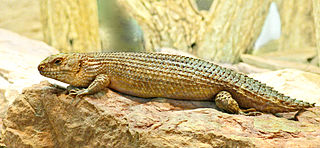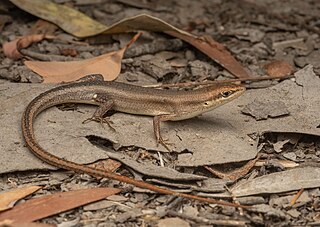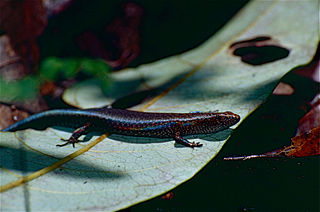
Carlia is a genus of skinks, commonly known as four-fingered skinks or rainbow skinks, in the subfamily Eugongylinae. Before being placed in this new subfamily, Carlia was recovered in a clade with the genera Niveoscincus, Lampropholis, and others of the Eugongylus group within Lygosominae.
Lygisaurus is a genus of skinks, lizards in the family Scincidae.

Egernia stokesii is a gregarious species of lizard of the Scincidae family. This diurnal species is endemic to Australia, and is also known as the Gidgee skink, spiny-tailed skink, Stokes's skink and Stokes's egernia. The species forms stable, long-term social aggregations, much like the social groups seen in mammalian and avian species. This characteristic is rarely found in the Squamata order, but is widespread within the Australian subfamily of Egerniinae skinks. Populations of E. stokesii are widely distributed, but fragmented, and occur in semi-arid environments. There are three recognised subspecies. The conservation status for the species is listed as least concern, however, one subspecies is listed as endangered.

The major skink is a species of lizard in the family Scincidae. The species is native to part of Australia and part of Australasia.
Slater's desert skink, also known commonly as the Centralian Floodplains desert-skink, Slater's egernia, and Slater's skink, is a species of lizard in the family Scincidae. The species is endemic to Australia. There are two recognized subspecies.

Carlia jarnoldae, also known commonly as the lined rainbow-skink or the lined rainbow skink, is a species of lizard in the subfamily Eugongylinae of the family Scincidae. The species is endemic to the state of Queensland in Australia.
Carlia johnstonei, also known commonly as the rough brown rainbow-skink, is a species of lizard in the family Scincidae. The species is endemic to the Australian state of Western Australia.

Carlia insularis, the black-throated rainbow-skink or hooded rainbow skink, is a species of skink in the genus Carlia. It is endemic to Queensland, Australia where it is found in "eastern creeks in the Wet Tropics".

Carlia rubrigularis, the red-throated rainbow-skink or the northern red-throated skink is a species of skink in the genus Carlia. It is endemic to Queensland, Australia.

Carlia schmeltzii, known commonly as the robust rainbow-skink, is a species of lizard in the family Scincidae. The species is endemic to Australia.

Carlia storri, also known commonly as the brown bicarinate rainbow-skink or Storr's carlia, is a species of lizard in the family Scincidae. The species was first described by Glen Joseph Ingram and Jeanette Covacevich in 1989. It is native to Papua New Guinea and the Australian state of Queensland.
Lampropholis adonis, also known commonly as the diamond shielded sunskink and Ingram's litter skink, is a species of skink, a lizard in the family Scincidae. The species is endemic to Queensland in Australia.
Lampropholis caligula, also known commonly as the montane sunskink or the montane sun skink, is a species of lizard in the family Scincidae. The species is endemic to New South Wales in Australia.

Lampropholis coggeri, also known commonly as the northern sun skink and the rainforest sunskink, is a species of lizard in the family Scincidae. The species is endemic to Queensland in Australia.

Lampropholis couperi, commonly known as the plain-backed sunskink, is a species of skink, a lizard in the family Scincidae. The species is endemic to Queensland, Australia.
Lygisaurus macfarlani, the translucent litter-skink, is a species of skink found in Queensland in Australia and Papua New Guinea.
Lygisaurus rimula, the crevice rainbow-skink, is a species of skink found in Queensland in Australia.
Concinnia frerei, also known commonly as the stout bar-sided skink or the stout barsided skink, is a species of lizard in the family Scincidae. The species is endemic to Queensland in Australia.
Ctenotus eurydice, also known commonly as the brown-backed yellow-lined ctenotus, is a species of skink, a lizard in the family Scincidae. The species is native to New South Wales and Queensland in Australia.
Lerista emmotti, also known commonly as the Noonbah robust slider, is a species of skink, a lizard in the family Scincidae. The species is endemic to Queensland in Australia.









